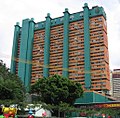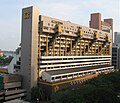William S. W. Lim
William S. W. Lim | |
|---|---|
林少偉 | |
 Lim in 2013 | |
| Born | 19 July 1932 |
| Died | 6 January 2023 (aged 90) Holland Road, Singapore |
| Nationality | Singaporean |
| Alma mater | |
| Occupations |
|
| Known for |
|
| William S. W. Lim | |||||||||||||||
|---|---|---|---|---|---|---|---|---|---|---|---|---|---|---|---|
| Traditional Chinese | 林少偉 | ||||||||||||||
| Simplified Chinese | 林少伟 | ||||||||||||||
| |||||||||||||||
William Lim Siew Wai (Chinese: 林少偉;[1] 19 July 1932 – 6 January 2023), commonly known as William S. W. Lim, was a Singaporean architect and conservationist. Some of his noted designs included the Tanglin Shopping Centre (1972), the People's Park Complex (1973), and the Golden Mile Complex (1974), all in Singapore. Lim wrote and lectured on a wide range of subjects relating to architecture, urbanism, and culture in Asia as well as on current issues relating to the postmodern, glocality, and social justice. He was the author of Asian Alterity: With Special Reference to Architecture and Urbanism through The Lens of Cultural Studies (2008), as well as editor of Asian Design Culture (2009) and co-editor of Non West Modernist Past (2011).
Early life and education
[edit]Lim was born on 19 July 1932 in British Hong Kong.[2] His father was Richard Lim Chuan Hoe, a lawyer and deputy speaker during David Marshall's government.[3] He graduated from the Architectural Association School of Architecture in London in 1955, and continued his graduate studies at Harvard University's Department of City and Regional Planning in the United States in the late 1950s. He had briefly worked for a year in London at their County Council. After completing his studies at Harvard University, being a Fulbright Fellow, Lim returned to Singapore in 1957. In Singapore, he did his apprenticeship under James Ferrie.[4][5]: 3 He told The Straits Times in 1997 that he never set out to be an architect, instead being a "process of elimination" as he "didn't want to become a lawyer, priest, teacher or doctor."[6]
Career
[edit]In 1960, he founded the architecture firm Malayan Architects Co-Partnership (MAC) alongside Chan Voon Fee and Lim Chong Keat. The three of them knew each other after meeting at a seminar in the United Kingdom, and decided to form a firm together when they returned to Malaya. They decided against using the names of partners for their firm's name, instead choosing a group name after being inspired by The Architects Collaborative. In the early days of MAC, they were unable to get any jobs and designed furniture.[5]: 2–3 One of the notable projects MAC did was in 1962, when they won a S$3,000 (US$980) prize after submitting a winning design of the to-be-built Trade Union House (present-day Singapore Conference Hall).[7][8] The design was praised by law minister K. M. Byrne, and the Trade Union House was constructed at a cost of S$4 million.[9]
Other competitions they participated in included the Shopping Centre for Ipoh Municipality in 1960, University Malaya Great Hall and Administration Buildings in 1962, and the Negeri Sembilan State Mosque in 1963; they won first prize for the latter.[5]: 3 In 1965, he was a founding member of the Singapore Planning and Urban Research Group (SPUR), alongside architects Tay Kheng Soon, Chee Soon Wah, Koh Seow Chuan, and Edward Wong. He served as its first chairman from 1966 to 1968.[10][11] SPUR was known as an "independent think-tank" and frequently commented on issues with Singapore's urban planning from the 1960s to 1970s.[12] In 1971, he attended the Second South Pacific Seminar in Fiji, where he presented a paper focusing on urbanisation and migration; he had previously presented papers at the 1967 Second Afro-Asia Housing Congress and at a 1970 UNESCO symposium.[13] That same year, Lim founded architecture firm Design Partnership with Tay and Koh, after MAC dissolved due to incompatibility between members.[5]: 6–7 With Design Partnership, Lim designed his most well known buildings, such as the People's Park Complex and Golden Mile Complex.[4]
In 1972, Lim was a part of the Design Partnership team who designed the People's Park Complex in Chinatown, which became known for its modern and brutalist architecture.[3][14] It was constructed over a period of years in the 1970s, spreading over 103,740 square feet (9,638 m2) and costing S$40 million (US$16.41 million).[15] The design for the People's Park Complex was the first to feature a multi-storeyed shopping centre with an atrium, which was subsequently repeated in other designs in Singapore.[6] While designing the People's Park Complex, Lim also designed the Tanglin Shopping Centre, which was developed by S.K. Chee Co. for S$7.5 million (US$3.05 million) and opened in 1972.[16] The following year, Lim designed the Golden Mile Complex with Tay and Gan Eng Oon, and it was completed in 1973. Originally known as the Woh Hup Complex, it was sixteen storeys tall and also incorporated brutalist architecture, further being described as a "vertical city" due to its mixed-use.[3][17]
In 1981,[18] he started his own business. He was a founding member of the Singapore Heritage Society[19] and a co-founder and chairman of Asian Urban Lab and President of the Architectural Association of Asia (AA Asia).[20] He was conferred a Doctor of Architecture Honoris Causa by the Royal Melbourne Institute of Technology (RMIT) University, Australia, in 2002 and appointed Honorary Professor of LaSalle-SIA College of the Arts (Singapore) in 2005.[21][22]
Lim wrote and lectured on a wide range of subjects relating to architecture, urbanism, and culture in Asia as well as on current issues relating to the postmodern, glocality, and social justice.[citation needed] He was the author of Asian Alterity: With Special Reference to Architecture and Urbanism through The Lens of Cultural Studies (2008), as well as editor of Asian Design Culture (2009) and co-editor of Non West Modernist Past (2011).[22]
Personal life
[edit]Lim was married to Lena Lim. The couple had two children, a son and a daughter.[4]
Lim died on 6 January 2023[a] at home in Holland Road in Singapore at age 90. He had suffered from COVID-19 in late-2022.[4]
Works
[edit]- 1972 – Tanglin Shopping Centre, Singapore
- 1973 – People's Park Complex, Singapore
- 1973 – Golden Mile Complex, Singapore
- 1987 – Church of Our Saviour (conversion), Singapore
- 1999 – Marine Parade Community Building, Singapore
- 2000 – Gallery Hotel, Singapore
-
People's Park Complex, Singapore
-
Golden Mile Complex, Singapore
-
Marine Parade Community Building, Singapore
-
Tanglin Shopping Centre, Singapore
Books
[edit]- Lim, William Siew Wai (1990). Cities for People : Reflections of a Southeast Asian Architect. Select Books. ISBN 981-00-1742-1. OCLC 851071649.
- Lim, William Siew Wai (1998). Contemporary Vernacular : Evoking Traditions in Asian Architecture. Select Books. ISBN 981-00-8370-X. OCLC 38464755.
- Lim, William Siew Wai (1998). Asian New Urbanism and Other Papers. Select Books. ISBN 981-4022-01-2. OCLC 231854270.
- Lim, William Siew Wai (2005). Asian Ethical Urbanism : A Radical Postmodern Perspective. World Scientific Pub. ISBN 981-256-313-X. OCLC 123237679.
- Lim, William Siew Wai (2008). Asian Alterity : With Special Reference to Architecture and Urbanism Through the Lens of Cultural Studies. World Scientific. ISBN 978-981-270-771-0. OCLC 845168576.
- Lim, William Siew Wai (2012). Incomplete Urbanism: A Critical Urban Strategy for Emerging Economies. World scientific. ISBN 978-981-4383-86-8. OCLC 800905300.
Notes
[edit]- ^ There is some confusion with Lim's date of death. The Straits Times reported that his date of death was 6 January 2023.[4] However, Channel News Asia, based on a statement from the Singapore Heritage Society, reported that his date of death was on 7 January.[2]
References
[edit]- ^ "我国先驱建筑师林少伟逝世 享年90岁". 8world (in Chinese (Singapore)). 8 January 2023 [7 January 2023]. Archived from the original on 7 January 2023. Retrieved 8 January 2023.
- ^ a b c "Celebrated architect William Lim dies aged 90". Channel NewsAsia. 7 January 2023. Archived from the original on 27 June 2023. Retrieved 7 January 2023.
- ^ a b c Sajan, Chantal (4 March 2023) [3 March 2023]. "The late William Lim: Pioneer architect, arts patron, heritage champion and social activist". The Straits Times. ISSN 0585-3923. Archived from the original on 21 July 2025. Retrieved 21 July 2025.
- ^ a b c d e f Sajan, Chantal (7 January 2023). "Pioneer architect behind People's Park Complex and Golden Mile Complex dies". The Straits Times. Archived from the original on 8 January 2023. Retrieved 8 January 2023.
- ^ a b c d M. Rasdi, Mohamad Tajuddin; Hayati Hussain, Nor. "National Identity And The Architecture Of Malayan Architect Co-Partnership" (PDF). Archived from the original (PDF) on 22 July 2011. Retrieved 20 July 2025.
- ^ a b "An outsider who cares and questions". The Straits Times. 25 October 1997. p. 15. Retrieved 20 July 2025 – via NewspaperSG.
- ^ "Work On Union House To Begin". The Straits Times. 20 March 1962. p. 4. Retrieved 20 July 2025 – via NewspaperSG.
- ^ "Winners Of Design Contest Named". The Straits Times. 18 March 1962. p. 6. Retrieved 20 July 2025 – via NewspaperSG.
- ^ "A building Singapore can be proud of – Byrne". The Straits Times. 3 October 1962. p. 11. Retrieved 20 July 2025 – via NewspaperSG.
- ^ Lim, Ivan (24 January 1972). "SPUR keeps a watching brief on things". New Nation. p. 9. Retrieved 20 July 2025 – via NewspaperSG.
- ^ "Chairman of SPUR". Singapore Herald. 6 March 1971. p. 14. Retrieved 20 July 2025 – via NewspaperSG.
Mr. William S. W. Lim is not the chairman of the Singapore Planning and Urban Research Group, as reported by the Herald on March 4. He was SPUR chairman from 1966–68. The present chairman is Mr. Tay Kheng Soon.
- ^ Zaccheus, Melody (8 October 2015). "Veteran architects of urban think-tank Spur reunite after 50 years". The Straits Times. ISSN 0585-3923. Archived from the original on 1 October 2020. Retrieved 29 July 2025.
- ^ "Lim for seminar". New Nation. 14 July 1971. p. 3. Retrieved 20 July 2025 – via NewspaperSG.
- ^ Ng, Keng Gene (30 May 2025) [27 May 2025]. "People's Park Complex being repainted red and white". The Straits Times. ISSN 0585-3923. Retrieved 21 July 2025.
- ^ Mok, Sin Pin (7 February 1972). "Majestic landmark in Chinatown". The Straits Times. p. 16. Retrieved 21 July 2025 – via NewspaperSG.
- ^ "Artist's impression of the Tanglin Shopping Centre at Tanglin Road". Roots. National Heritage Board. Archived from the original on 19 April 2025. Retrieved 21 July 2025.
- ^ "Where shoppers can buy all their needs under one roof". The Straits Times. 22 April 1973. p. 28. Retrieved 21 July 2025 – via NewspaperSG.
- ^ "Cities on the Move". Rama9art.org. Archived from the original on 3 December 2009. Retrieved 7 January 2023.
- ^ "CV OF WILLIAM S W LIM" (DOC). Reasonablespread.com. Retrieved 7 January 2023.
- ^ Lim, William S. W. (1 December 2006). "Asian architecture in the new millennium: A postmodern imagery". Ekistics and the New Habitat. 73 (436–441): 132–139. doi:10.53910/26531313-E200673436-441108. ISSN 2653-1313. Archived from the original on 8 January 2023. Retrieved 8 January 2023.
- ^ "BACK MATTER", The Impossibility of Mapping (Urban Asia), WORLD SCIENTIFIC, pp. 262–278, 1 February 2020, doi:10.1142/9789811211935_bmatter, ISBN 978-981-12-1192-8, S2CID 243016545, retrieved 8 January 2023
- ^ a b "William Lim Siew Wai | Infopedia". eresources.nlb.gov.sg. Archived from the original on 8 January 2023. Retrieved 8 January 2023.
- ^ "William Lim Associates and W Architects Pte Ltd collection :Church of Our Saviour : submission drawings (DC and BP),1986-1898. – National Library". nlb.gov.sg. Archived from the original on 8 January 2023. Retrieved 8 January 2023.
External links
[edit]- William S. W. Lim on Infopedia
 Media related to William S. W. Lim at Wikimedia Commons
Media related to William S. W. Lim at Wikimedia Commons




